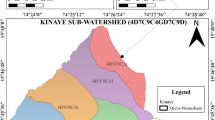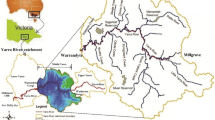Abstract
Suitable and practicable best management practices (BMPs) need to be developed due to steadily increasing agricultural land development, intensified fertilization practices, and increased soil erosion and pollutant loads from cultivated areas. The soil and water assessment tool model was used to evaluate the present and future proper BMP scenarios for Chungju dam watershed (6,642 km2) of South Korea, which includes rice paddy and upland crop areas. The present (1981–2010) and future (2040s and 2080s) BMPs of streambank stabilization, building recharge structures, conservation tillage, and terrace and contour farming were examined individually in terms of reducing nonpoint source pollution loads by applying MIROC3.2 HiRes A1B and B1 scenarios. Streambank stabilization achieved the highest reductions in sediment and T-N, and slope terracing was a highly effective BMP for sediment and T-P removal in both present and future climate conditions.




Similar content being viewed by others
References
Alcamo J, Döll P, Kaspar F, Siebert S (1997) Global change and global scenarios of water use and availability: an application of water GAP 1.0. Report A9701. University of Kassel, Kassel
Arabi M, Frankenberger JR, Engel BA, Arnold JG (2007) Representation of agricultural conservation practices with SWAT. Hydrol Process 22(16):3042–3055
Arnell NW (2003) Relative effects of multi-decadal climatic variability and changes in the mean and variability of climate due to global warming: future streamflows in Britain. J Hydrol 270(3–4):195–213
Arnell NW (2004) Climate-change impacts on river flows in Britain: the UKCIP02 scenarios. J Chart Inst Water Environ Manag 18(2):112–117
Arnold JG, Fohrer N (2005) SWAT2000: current capabilities and research opportunities in applied watershed modelling. Hydrol Process 19(3):563–572
Arnold JG, Williams JR (1987) Validation of SWRRB: simulator for water resources in rural basins. J Water Resour Plan Manag 113(2):243–256
Arnold JG, Srinivasan R, Muttiah S, Williams JR (1998) Large-area hydrologic modelling and assessment: part I. Model development. J Am Water Resour Assoc 34(1):73–89
Bouraoui F, Galbiati L, Bidoglio G (2002) Climate change impacts on nutrient loads in the Yorkshire Ouse catchment (UK). Hydrol Earth Syst Sci 6(2):197–209
Bracmort KS, Arabi M, Frankenberger JR, Engel BA, Arnold JG (2006) Modeling long-term water quality impact of structural BMPs. Trans ASABE 49(2):367–374
Cho JH, Sung KS, Ha SR (2004) A river water quality management model for optimizing regional wastewater treatment using a genetic algorithm. J Environ Manag 73(3):229–242
Chow VT (1959) Open-channel hydraulics. McGraw-Hill, New York
Cullen AC, Frey HC (1999) Probabilistic techniques in exposure assessment: a handbook for dealing with variability and uncertainty in models and inputs. Plenum Press, New York
Droogers P, Aerts J (2005) Adaptation strategies to climate change and climate variability: a comparative study between seven contrasting river basins. Phys Chem Earth 30(6–7):339–346
Gassman PW, Reyes MR, Green CH, Arnold JG (2007) The soil and water assessment tool: historical development, applications, and future research directions. Trans ASABE 50(4):1211–1240
Green CH, van Griensven A (2008) Autocalibration in hydrologic modeling: using SWAT2005 in small-scale watersheds. Environ Model Softw 23(4):422–434
IPCC (2007) Climate change 2007: the physical science basis, contribution of working group I to the 4th assessment report of the intergovernmental panel on climate change. Salomon S, Qin D, Manning M, Chen Z, Marquis M, Averyt KB, Tignor M, Miller HL (eds) Cambridge University Press, Cambridge
IPCC-TGCIA (1999) Guidelines on the use of scenario data for climate impact and adaptation assessment: version 1. In: Carter TR, Hulme M, Lal M (eds) Intergovernmental panel on climate change, task group on scenarios for climate impact assessment. Available at: www.ipcc-data.org/guidelines/TGICA_guidance_sdciaa_v1_final.pdf
Izaurralde RC, Williams JR, McGill WB, Rosenberg NJ, Quiroga Jakas MC (2006) Simulating soil C dynamics with EPIC: model description and testing against long-term data. Ecol Model 192(3–4):362–384
Knisel WG (1980) CREAMS, a field-scale model for chemicals, runoff, and erosion from agricultural management systems. USDA conservation research report no. 26. Washington
Koch H, Grünewald U (2009) A comparison of modelling systems for the development and revision of water resources management plans. Water Resour Manag 23(7):1403–1422
Kwon YA, Kwon WT, Boo KO, Choi YE (2007) Future projections on subtropical regions over South Korea using SRES A1B data. J Korean Geogr Soc 42(3):355–367
Lane LJ (1983) Chapter 19: transmission losses. In: Soil conservation service. National engineering handbook, section 4: hydrology. US Government Office, Washington, p 19–21
Lazar B, Williams M (2008) Climate change in western ski areas: potential changes in the timing of wet avalanches and snow quality for the Aspen ski area in the years 2030 and 2100. Cold Reg Sci Tech 51(2–3):219–228
Leonard RA, Knisel WG, Still DA (1987) GLEAMS: groundwater loading effects of agricultural management systems. Trans ASAE 30(5):1403–1418
Nakicenovic N, Alcamo J, Davis G, de Vries B, Fenhann J, Gaffin S, Gregory K, Grubler A, Jung TY, Kram T, La Rovere EL, Michaelis L, Mori S, Morita T, Pepper W, Pitcher H, Price L, Raihi K, Roehrl A, Rogner H–H, Sankovski A, Schlesinger M, Shukla P, Smith S, Swart R, van Rooijen S, Vitor N, Dadi Z (2000) Emissions scenarios. A special report of working group III of the intergovernmental panel on climate change. Cambridge University Press, Cambridge
Narasimhan B, Allen PM, Srinivasan R, Bednarz ST, Arnold JG, Dunbar JA (2007) Streambank erosion and best management practice simulation using SWAT. In: Proceeding of 4th conference on watershed management to meet water quality standards and TMDLs, ASABE publication #701P0207, San Antonio, 10–14 March, 2007
Nash JE, Sutcliffe JV (1970) River flow forecasting through conceptual models part I: a discussion of principles. J Hydrol 10(3):282–290
Neitsch SL, Arnold JG, Kiniry JR, Williams JR, King KW (2002) Soil and water assessment tool: theoretical documentation, version 2000. TWRI report TR-191. Texas Water Resources Institute, College Station
Park JY, Park MJ, Ahn SR, Park GA, Yi JE, Kim GS, Srinivasan R, Kim SJ (2011) Assessment of future climate change impacts on water quantity and quality for a mountainous dam watershed using SWAT. Trans ASABE 54(5):1725–1737
Park MJ, Shin HJ, Park JY, Park GA, Srinivasan R, Kim SJ (2012) Technical note: comparison of watershed streamflow using projected MIROC3.2 HiRes GCM data and observed weather data for 2000–2009 under SWAT simulation. Trans ASABE 55(3):1003–1010
Racsko P, Szeidl L, Semenov M (1991) A serial approach to local stochastic weather models. Ecol Model 57:27–41
Schwab GO, Fangmeier DD, Elliot WJ (1995) Soil and water management systems, 4th edn. Wiley, New York
SCS Engineering Division (1986) Urban hydrology for small watersheds. US Department of Agriculture, technical release 55. USDA, Washington
Secchi S, Gassman PW, Jha M, Kurkalova L, Feng HH, Campbell T, Kling CL (2007) The cost of cleaner water: assessing agricultural pollution reduction at the watershed scale. J Soil Water Conserv 62(1):10–21
Semenov MA, Barrow EM (2002) LARS-WG: a stochastic weather generator for use in climate impact studies: user manual. Rothamsted Research, Harpenden. Available at: www.rothamsted.ac.uk/masmodels/download/LARS-WG-Manual.pdf
Semenov MA, Brooks RJ, Barrow EM, Richardson CW (1998) Comparison of WGEN and LARS-WG stochastic weather generators for diverse climates. Clim Res 10(2):95–107
Srinivasan R (2008) Bosque river environmental infrastructure improvement plan: phase I final report. TR-312, Texas Water Resources Institute, Texas A&M University, College Station
Tuppad P, Kannan N, Srinivasan R, Rossi CG, Arnold JG (2010) Simulation of agricultural management alternatives for watershed protection. Water Resour Manag 24:3115–3144
USDA-SCS (1972) National engineering handbook. Hydrology section 4, chapters 4–10. Washington
Vache KB, Eilers JM, Santelmann MV (2002) Water quality modeling of alternative agricultural scenarios in the US corn belt. J Am Water Resour Assoc 38(3):773–787
Wilby RL, Greenfield B, Glenny C (1994) A coupled synoptic-hydrological model for climate change impact assessment. J Hydrol 153(1–4):265–290
Williams JR (1975) Sediment routing for agricultural watersheds. Water Resour Bull 11(5):965–974
Williams JR (1990) The erosion productivity impact calculator (EPIC) model: a case history. Phil Trans R Soc Lond B 329(1255):421–428
Acknowledgments
This study was supported by the Center for Aquatic Ecosystem Restoration (CAER) of the Ecostar project from the Ministry of Environment (MOE), Republic of Korea (MOE; EW-55-12-10), and the National Research Foundation of Korea (NRF) grant funded by the Korea government (MEST) (No. 2013-065006).
Author information
Authors and Affiliations
Corresponding author
Rights and permissions
About this article
Cite this article
Park, JY., Yu, YS., Hwang, SJ. et al. SWAT modeling of best management practices for Chungju dam watershed in South Korea under future climate change scenarios. Paddy Water Environ 12 (Suppl 1), 65–75 (2014). https://doi.org/10.1007/s10333-014-0424-4
Received:
Revised:
Accepted:
Published:
Issue Date:
DOI: https://doi.org/10.1007/s10333-014-0424-4




